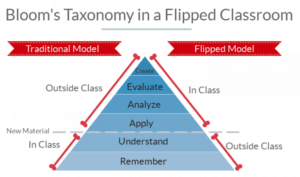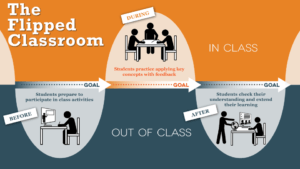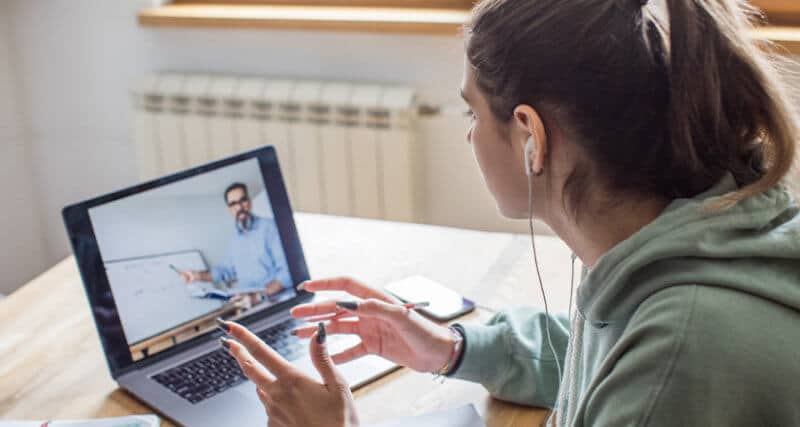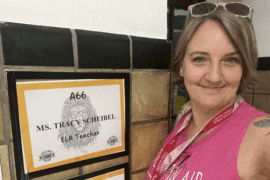Flip It: Flipped Classroom Basics for the New Normal
The school year is ending this week for many around the country. I think it’s safe to say that most teachers, students, and parents would agree it was a weird, sad, unfulfilling ending. Teachers didn’t get to say proper goodbyes to students or colleagues, kids didn’t get to say goodbye to their classmates, and graduation ceremonies moved to an impersonal online format.
Perhaps the most unsettling thing is we still don’t know what school will look like when we resume in the fall. Most states are only beginning to formulate plans for reopening schools, and those plans could quickly change if there is a “second wave” of COVID-19 infections. The reality is that, until there is widely available testing and a vaccine, schools will not look the same as they did when they shut down in March.
In a recent blog from one of my favorite education bloggers, Jennifer Gonzales, she outlines 7 different solutions for schools reopening. They range from staggered or alternating schedules to a one-room schoolhouse model to students working from individual learning plans (an intriguing idea). As I read, I couldn’t help but find a common thread among several of the solutions: students would have to do some of their learning remotely from home and possibly also do some learning in a room with a smaller number of students than usual (per CDC guidelines).
In other words, many possible solutions would call for teachers to flip their classrooms to some extent. Since flipping is a real possibility for how learning will take place in the near future, I think it’s important for all teachers to gain a grasp of this model, including the benefits and challenges it poses, and consider how they might use the model with their own students.
What is Flipped Learning?
Let’s start with an accurate, coherent definition of flipped learning, since there are several different interpretations out there. Jon Bergmann, a pioneer of the Flipped Class Movement and cofounder of the Flipped Learning Network, defines flipped learning this way:
“… a pedagogical approach in which direct instruction moves from the group learning space to the individual learning space, and the resulting group space is transformed into a dynamic, interactive learning environment where educators guide students as they apply concepts and engage creatively in the subject matter.”
So flipped learning is really about what is happening first in the “individual space,” when students are on their own either at home, in a library, etc., and then what is happening in the “group space,” when they are with their teacher and classmates.
If we think about Bloom’s taxonomy, the goal of the individual space is to have students be introduced to new materials and just begin to remember and understand them. While the goal of the group space is for students to dive into the higher levels of Bloom’s together, in a space where the teacher and classmates are there to support them (see the image below).

This is the opposite of a traditional classroom (especially at the secondary level), where students are often introduced to new concepts in class primarily through lecture and textbooks and then have homework that requires them to engage with (and sometimes struggle with) the new concepts at a higher level on their own (see the image below).

I adopted the flipped learning model in my English classroom about four years ago due to my frustration with the traditional model pictured above. I wanted my limited class time to work individually or in small groups with my students and guide them through the difficult work of readers and writers workshop, so I started putting my “lessons” online. It was tricky at first to get students to watch regularly the lessons before class (more on that later…), but once they got the routine down, our class time was so much more interactive and meaningful, and it showed in the higher quality of their writing and greater engagement in their reading. It also gave me more time to get to know my students and to build more meaningful relationships. After my first year, I couldn’t ever see going back to a traditional model.
Start Thinking in Terms of Before, During & After Class
As teachers move their classes to a flipped model, they must first start thinking about everything in terms of before, during, and after class work. The before-class work happens in the individual space when students are being introduced to new concepts. The during-class work happens in the group space when students are interacting and doing hands-on activities to apply the new concepts. The after-class work is when students are demonstrating and reflecting on their learning (see the image below).

When planning before-class work, the Flipped Learning Network offers some best practices to keep in mind. First, consider using a mixture of resources, including both text-based and video-based materials. Having different ways to access the content is so important since we know our students learn in different ways. Also, having graphic organizers for students to record what they are learning as they read or watch is so important. In addition, instructors need to model how to use these graphic organizers, especially early on.
Second, “chunk” the work by week and organize each week’s content in a way that is simple, consistent, and user-friendly. Part of how you organize work may depend on the learning management system provided by your school district. However, this short video by John Spencer explains how teachers can use the basic principles of User Experience Design theory to organize better any online work.
Finally, the more teachers can personalize the before-class work, the better. Several studies have shown that students are more apt to engage with a video, even a simple screencast, if their teacher rather than a stranger makes it. Simple, free screencast tools like Screencastify and Screencast-o-matic make it easy for teachers to make their own videos. Teachers can also curate existing videos using simple tech tools like EdPuzzle so students feel like a video has been personalized for them without a teacher having to totally recreate the wheel. For a run-down of best practices for making your own instructional videos, check out this article from Edutopia.
During-class work should be about active learning that encourages student interaction. It should also connect back to the before class work and prepare students for the after class work. The teacher becomes the facilitator of learning by constantly circulating the room to answer questions and provide individual feedback. Since you only have students in front of you for a limited amount of time, make the most of it with some of these active learning strategies.
After class work is when students can complete assessments to check their understanding and/or reflect on what they learned from the before- and during-class time. This is why a flipped class model lends itself well to project-based or mastery-based learning, which are initiatives in many school districts right now. An instructor can get students working on a project during class and then they can finish or reflect on the project after class. Because students may be finishing these projects or assessments on their own, it’s critical that teachers provide them with models and rubrics that make expectations clear.
Overcoming Challenges to Flipping
To prevent some challenges from ever arising, schools must first clearly communicate to both students and parents what flipped learning is, and why they are using the model. Getting student and parent buy-in from the start is crucial.
Next, schools also need to make a plan for students who will need more support. The COVID-19 closures this year have exposed inequities in communities all across the country. We are now more acutely aware that some of our families do not have access to the internet and other technologies. Some parents, for multiple reasons, cannot provide a stable learning environment for their children. Some children really struggle to learn in a virtual environment, especially those with certain disabilities and English Language Learners.
We must address these inequities in order for a flipped learning model to work. Maybe more hotspots need to be purchased? Maybe certain students will need to be at school to complete their before- and after-class work because it simply can’t happen at home? Some may need support from an instructor or instructional aide to get it done. All of this requires careful planning.
A final challenge is how to hold students accountable, especially for the before-class work, because if the before-class work isn’t done, the model kind of falls apart. Let’s face it, sometimes students who have access to technology and support at home still won’t want to do the work to prepare for class. I ran into this many times in my English classes and found there were two main ways to curb this behavior. First, keep parents informed of progress – or lack thereof. Try to approach it as creating a partnership with parents to ensure students are learning.
Second, do not give in and give the lesson in class for those who didn’t do the work on their own. That only sends the message that students don’t need to do the before-class work. Instead, students may have to sit and do the before-class work in-class before engaging in any active learning. Trust me, when a student watches her peers do cool activities while she sits to the side at a computer, she usually learns quickly to do the before-class work.
I realize that I just provided a lot of information to take in, so I suggest approaching a flipped model slowly (if the future situation at your school allows). Take your time to go through the resources in this article plus the additional ones below. Start by just thinking how you would flip one lesson. Then you can expand to a short unit, then to a longer unit. Even if your school doesn’t end up fully adopting a flipped model, you may think of ways to use technology to buy yourself more individual time with your students or to provide more hands-on learning in the classroom, and that would definitely make it worth it.
Additional Resources:
- Flipped Learning Global Network
- Flip Your Classroom: Reach Every Student in Every Class Every Day by Jon Bergmann & Aaron Sams
- Vanderbilt University Center for Teaching
- Edutopia articles on Flipped Learning
- Schoology’s Guide to Flipped Learning
- Megan Panek





